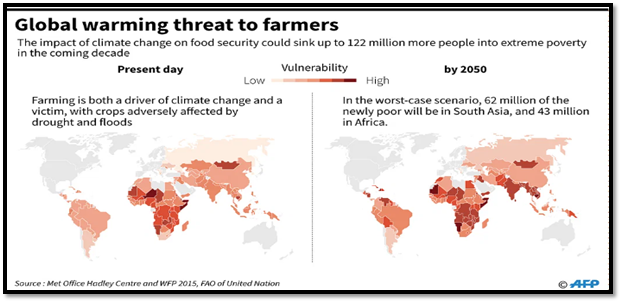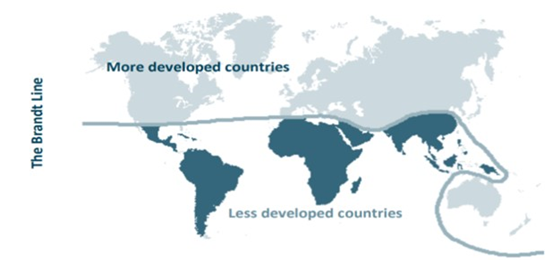24 Mar
Climate change and women
Why in news? As we celebrate International Women Day on 8 March , 2023 , it is important to recognize the vital role that women play in tackling climate change.
Background:
- Climate change is a planetary phenomenon that will impact all people, but its effects are being shaped by pervasive and entrenched gender inequality.
- Heat waves, droughts, rising sea levels, and extreme storms disproportionately affect women. That’s because women are more likely to live in poverty than men, have less access to basic human rights like the ability to freely move and acquire land, and face systematic violence that escalates during periods of instability.
- The IPCC [Intergovernmental Panel on Climate Change] found that gender inequalities are further exaggerated by climate-related hazards, and they result in higher workloads for women, occupational hazards indoors and outdoors, psychological and emotional stress, and higher mortality compared to men.
- Gender inequality hampers women’s capacity and potential to be actors of climate action. These gender inequalities — access to and control over resources, access to education and information, and equal rights and access to decision-making processes — define what women and men can do and cannot do in a particular context of climate change.
Vulnerability faced by women during disasters and climate change
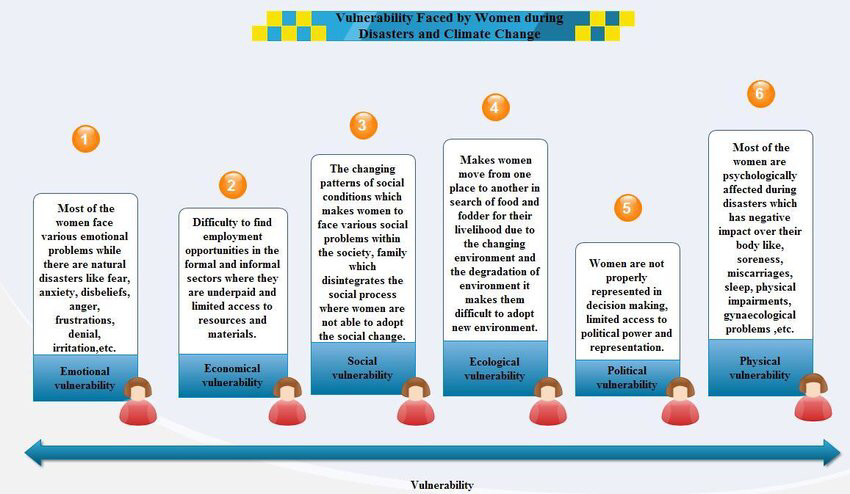
Issues of Climate Change on Women
- There are various issues related with climate change on some of the major issues are natural resources, natural disasters, health, population growth, urbanisation migration, household composition, conflict and violence, etc. The World Food Programme estimates 10-20 percent of the people face heavy risk of hunger by 2050 globally due to climate change :
- Natural resources: The challenge of maintaining sustainable livelihoods in a degrading environment is also a gender sensitive issue. Women are vulnerable and produce up to 90% of natural resources.
- Natural disasters: Changing weather patterns and seasons , intense weather , sea level increase makes negative impact on women. Life saving skills are mostly taught to men and women are excluded in decision making during disasters. In 2004, Tsunami in Indian Ocean, average of 77% casualties were women, as they were not taught to swim.
- Health: During climate change and disasters , water borne diseases, malnutrition , depression are the major impact over women. Rural women spend 210 hours in each year for fetching water has a loss of 27 days wages.
- Population growth: Developing countries increasing population makes the impact of livelihood challenges on women more vulnerable and brings higher fertility impact on health. Underweight and stunted women without adequate food delivers low birth weight child or malnourished child.
- Urbanisation: Migration and displacements are quite common for both men and women during Mostly women get affected when they migrate to urban areas where they face unhealthy situations, lack of sanitation, clean drinking water shows some of the direct impact on women. Women in slums comparing with non-slum counterparts, majority of them have children at an earlier age .
- Conflict and violence: Conflict and violence would arise when there is huge competition in finding natural resources like food, fodder and water. Mostly men are killed and injured while protecting their family members. This leads to female headed families and they face the violence of rape, assault etc.
CASE STUDY : crisis. A study of the tea plantations in Darjeeling, West Bengal, finds that in the last few years, the excessive use of fertilisers in the production of tea (a need that arose due to climate and ecological deterioration) has severely affected female tea workers, for they constitute the cheaper source of labour in tea garden. They have suffered vision loss, skin infections, loss of appetite, and breathing ailments. Women form the majority of the agricultural workforce in rural India, a field which is especially vulnerable to climate change. Despite their vast knowledge and experience, they continue to hold very limited land-owning rights and minimal financial resources, which put them at a disadvantage in mitigating any climate-related crisis.
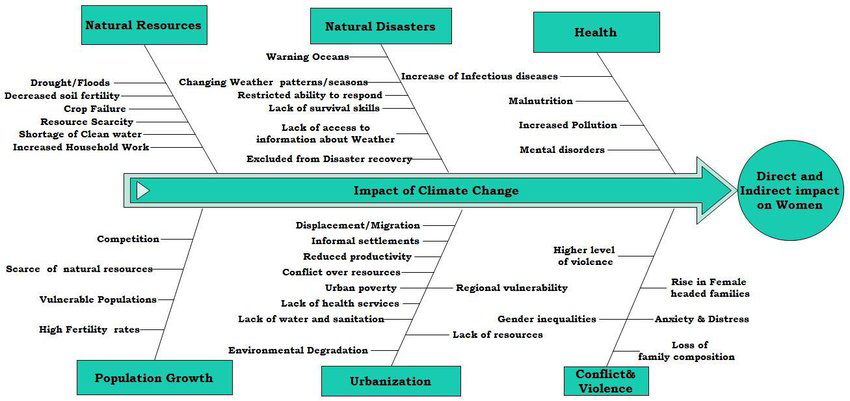
Women’s contribution to climate change
- Poverty: Women living in poverty are least responsible to climate change. In developing countries, poor women are less likely to own private transport , take flights, have appliances that produce green house gas emissions.
- Women roles: Prescribed gender roles such as domestic work , child care enable women to spend on essential items of household , including food, fuel and clothing , leaving less consumption of consumer goods.
- Behaviour and consumption pattern: E map survey revealed that women were 12% more likely than men to purchase environmentally friendly products and services , and 10% more likely to give consideration to what companies said about their impact on environment.
- Patriarchy: The world economic system is patriarchal . Few women hold positions of real power that allow them to change or challenge it. Men dominate decision making in most of the polluting industries , failing to give enough priority to tackle full climate change.
Women as Agents of Climate Action
- Climate action requires 100 percent of the population : If we want to achieve the Paris Agreement goal of limiting global temperature rise to 1.5 degrees Celsius, we need women, in all their diversity, involved at all levels – from climate negotiations to boardrooms to forests and fields, especially in sectors and regions hit hard by the ravages of climate change.By including more women in climate action, we can create a more sustainable and equitable future for all.
- Empowering women means better climate solutions: When provided with the same access to resources as men, women can increase their agricultural yields by 20 to 30 percent. By empowering women , providing appropriate technology and resources, we can promote more sustainable farming and conservation practices. Research shows that countries with high representation of women in parliament are more likely to ratify international environmental treaties.
- Women are key to building climate resilience in communities: UN reports that communities are more successful in resilience and capacity-building strategies when women are part of the planning process. Additionally, women are usually first responders in community responses to natural disasters, leaders in disaster risk-reduction, and contribute to post recovery .
- Climate change affects us all, but not equally: Particularly in developing countries, the consequences of climate change can increase the burden for women and girls, for example, causing them to travel further to obtain daily supplies, leaving less time for paid work and potentially exposing them to greater risk to their personal safety.
- Countries recognize the importance of gender in climate planning: Within the UN Climate Change process, many countries have shared how they are integrating gender across different priority sectors within their national climate action plans (Nationally Determined Contributions) and National Adaptation Plans.Governments meeting under the UNFCCC adopted a goal of gender balance in national delegations and in national climate policy and action.
Women’s key demands for COP 21 : Paris agreement
omen’s Key Demands for COP21:Paris Agreement 2015
- The agreement must ensure human rights, gender equality, and rights of indigenous peoples, equity, food security, integrity and resilience.
- New approaches towards gender sensitiveness, responsibility and transparency.
- Gender responsive transfer of safe Technology and development for people and the environment.
- Gender responsive public funds without ceiling should be provided each and every year 50:50 for five years for developed countries
Increase women participation in climate change negotiations
- Quotas can be provided not only to increase participation but also to address inequalities:Measures, including quotas can be put in place to address persisting inequalities in terms of their access and control of resources such as land, technology, and finance.
- Integrating a gender perspective across spectrums:Efforts to be made by the policy makers to integrate a gender perspective across spectrums, ranging from design, monitoring and evaluation, implementation and funding of all national climate policies, plans and actions to ensure that the needs and concerns of women are being adequately addressed.
- Expanding gender responsive finance and services:Member states must expand gender-responsive finance as well as gender-responsive public services, healthcare systems, universal social protections, combining measures both to eliminate gender-based violence in climate policies and to promote a care economy, thereby, guaranteeing the provision and access to justice for women.
- Implementing the ways to multiply gender equality, thereby empowering women to harness their skills: Identify and implement ways to multiply gender equality, empowering women and young girls. Global investments, to be focused on directly amplifying and fostering their skills, resilience and knowledge, thereby, removing critical barriers that hinder their participation in decision-making positions.
Way forward:
- Focusing on gender analysis and gender mainstreaming with the increase of political commitment with the collaboration of Cooperating in reducing climate change, poverty and gender issues through civil societies.
- Reviewing laws, policies, plans, budgets and taking necessary action against gender issues through developmental policies.
- Taking administrative measures through various policies and link them between disasters, climate change reduction through gender perspective.
- Developing gender sensitive indicators through collecting gender statistics on the impact of disasters, assessments on vulnerability and risk.
- Reducing disaster making awareness through public media on gender sensitivity, vulnerability and risk reduction through gender specific needs.
- To study on disaster, risk reduction, climate change with gender sensitivity with the support of research institutions.
- Including development policy making to prevent disasters and make assessments to prevent poor becoming poorer.
- Making equal participation of men and women in preparing them to disaster preparedness through capacity building and training.
- Enabling gender mainstreaming among all the development sectors through various capacity training to professional organisation communication, local bodies, etc.
Conclusion :
Women in the whole world do not have much assets compared with men, mostly all the assets are owned by men. When men try to conquer the nature it sometimes shows negative impacts on women. As they are jealous to incorporate higher amount of assets by the name of encroaching river beds, streams, forests and other natural resources which leads to the depletion of nature. This reflects on women during a natural disaster where women are forced to migrate and are vulnerable in nature. On the other side the developed nations impose their globalization ethics over the developing nations through the form of multinational corporations which are involve in mining, digging which affects environment and brings indirect impact over women. The impacts on climate change-drought, flood, increasing diseases, food scarcity, bad weather, excessively affect the world’s 1.3 billion poor, in which the majority of them are women. It is essential that the role of government and civil societies to come forward in combating climate change and protect nature as well as to make an end to women vulnerability.
Paper I (General Studies): Role of women in society
Paper I (Geography Optional): Environment degradation, management and conservation, Sustainable development, Environmental education and legislation
NGT orders action on fish farm, mandates nation-wide strict regulations
Why in news? A recent judgement by the National Green Tribunal (NGT), Western Zone bench, concerning aquaculture practices in Vadivale Lake at Maval taluka of Pune, is likely to have far-reaching implications for the industry nation-wide
Background:
- The number of intensive fish farms in the India continues to rise. Fish farming is not a solution to overfishing the oceans, as wild fish are still caught and fed to farmed fish. And while ocean fishing is really bad for the environment, so is farming fish, with the pollution emitted damaging natural waterways and killing wild animal populations.
- The documentary Seaspiracyrevealed the serious human, animal and environmental injustices associated with the fishing industry.
WHAT IS FISH FARMING?
- Fish farming is the breeding and rearing of aquatic animals in captivity for the sole purpose of killing and eating them. All fish farming is intensive, and brings with it a whole host of serious welfare and environmental problems.
FISH FARMING METHODS USED
Depending on the species being farmed and the resources available, different systems may be used.
- Cage System: Fish may be kept in cages which are immersed in a river, stream, lake, reservoir or ocean. All the chemicals used to try and keep the fish alive and all the waste they produce goes directly into the natural environment where it impacts wildlife.
- Irrigation Ditch Or Pond Systems: Fish are introduced to a water-filled ditch or pond, and are fattened up on artificial foods, which often includes soy from deforested lands.
- Integrated Recycling Systems: Large plastic tanks are placed inside hydroponic greenhouses – where plants are grown without soil – and the waste from the fish feeds the plants. This causes welfare problems for the fish who are kept inside those plastic tanks.
- Indoor Fish Farming: Not all fish are reared outdoors. Like many factory farmed animals – including almost all chickens and most pigs – they are brought inside for the convenience of the farmer, and may never experience the natural environment where they belong. One of the “benefits” of this system, according to the industry, is that stocking densities can be even higher, meaning these farms can have incredibly crowded conditions.
HOW ARE FARMED FISH KILLED?
There are several methods of slaughtering fish, but all are crude and cause suffering.
- Air Asphyxiation: Fish cannot breathe in air, and so this method allows fish to suffocate to death in the open air, a process that can take more than 15 minutes.
- Ice Baths or Chilling: It means being frozen to death. Research has shown that this process actually elevates cortisol – the major stress hormonein fish – and the animals remain conscious for longer than some other methods.
- Exsanguination Without Stunning: Here, the animals are cut and bled to death without any prior stunning. According to the Food and Agriculture Organization of the United Nations,“fish may remain conscious for 15 minutes or more between the time when major blood vessels have been cut and when they lose consciousness. Eel brains may continue to process information for 13-30 minutes after being decapitated and some fish remain conscious for 20-40 minutes after evisceration” – that is, the removal of their insides.
- Percussive Stunning: Sometimes fish are stunned before being slaughtered, and with this method, they are beaten on their heads until they lose consciousness.
- Electric Stunning: This is electrocution and may be done in or out of the water. While it is probably the least inhumane form of stunning, it is far from failsafe. If the voltage or duration of the stun is insufficient, the animal may be immobilized, but remain fully conscious.
WHY IS FISH FARMING BAD?
There are just a few ways in which aquatic animals suffer in farms:
- Handling And Transportation: “During transport, fish are exposed to a multitude of stressors such as density changes, handling stress, water movement, noise and vibrations, and poor water conditions. Exposure to such stressors simultaneously or in rapid succession may induce severe physiological stress.
- Lack Of Space And Crowded Conditions: More animals farmed equals more profit.Overcrowding causes stress, allows disease to spread, and creates large amounts of waste that have a detrimental impact on the environment.
- Light Disturbance: Measures such as artificial lightning are used to speed up growth in order to make more money. It is intended to reduce the time the baby fish sleep. When they’re not sleeping, they’re eating, and so they grow faster and bigger. Use of lighting in salmon farming is associated with weakened bones and possible skeletal deformities.
- Hunger: Before subjecting the fish to stressful events food may be withheld from fish, often for two to three days, but sometimes for as long as two weeks.
- Deliberately Blinded: Shrimp are not suited to being farmed and many of those kept in captivity are not able to reproduce. Farmers realized that cutting off their eyestalks, which blinds them, triggers the maturing of their ovaries, and so blinding these little animals has become the norm.
HOW FISH FARMS THREATEN THE ENVIRONMENT?
- Diseases: Farmed animals get sick because their immune systems are compromised by the stressful conditions, and because pathogens can spread quickly in those overcrowded conditions. One example is sea lice – tiny crustaceans that eat fish alive. It’s a horrible – and horribly common – disease on farms.
- Water Pollution: Farmed fish are treated with harsh chemicals to try and keep them alive in those squalid conditions. Inevitably these also get out into wild waters and pollute them. When these get into the waterways, the nutrients they contain increase the risk of algal blooms, which deplete oxygen in the water, killing wild aquatic life and creating ‘dead zones’. Research by UNESCO’s Intergovernmental Oceanographic Commissionfound that the harm caused by algal blooms has risen in step with the growth of fish farming.
- Invasive Species: Fish regularly escape from farms, and when they do, they not only take their pathogens with them, but they may cause devastation to the delicate local ecosystem just by inserting themselves into it. They may prey on native species, wiping out local populations, or they may become food for another species.
- Seals and Sea Lions Deliberately Killed: To ‘protect’ the fish long enough to get them to slaughter, wild animals attracted by the buffet of fish are also killed. This includes the deliberate shooting of otters, beavers, sea lions and seals, as well as aquatic birds like cormorants.
CONCLUSION
- Fish farming is bad news for both captive and wild fish, and causes mayhem in the natural environment. But the good news is we do not need to eat fish, and can get all the fishy flavors we love and the nutrients we need for optimal health from plant foods. The omega-3 acids in oily fish that we are recommended to eat, for example, can be found in walnuts and elsewhere, so we can leave the fish in the wild where they belong, and help protect the environment, too.
Where to use?
Paper I (Geography optional): Environmental degradation and management, Marine resources
Paper II (Geography optional): Ecological issues, Agro based industries.
Atmospheric Rivers
Why in news? Recently forecasters in the US have said that the rain arriving in California is caused by atmospheric rivers.
Background:
WHAT IS AN ATMOSPHERIC RIVER?
- The term atmospheric river is used to indicate narrow, elongated corridors of concentrated moisture transport associated with extratropical cyclones. Atmospheric rivers are the largest transport mechanisms of freshwater on Earth.
- This moisture transport occurs under particular combinations of wind, temperature, and pressure conditions.
- Atmospheric rivers are typically located within the low-level jet, an area of strong winds in the lower levels of the atmosphere, ahead of the cold front in an extratropical cyclone.
- Based on satellite observations, an atmospheric river is greater than ~2,000 km (1,245 miles) long, less than 1,000 km (620 miles) wide, and averages 3 km (1.8 miles) in depth.
- Typical atmospheric river conditions last around 20 hours over an area on the coastline.
- Strong landfalling atmospheric rivers interact with topography and can deposit significant amounts of precipitation in relatively short periods of time leading to flooding and mudslides.
- Atmospheric rivers also can have beneficial impacts by contributing to increases in snowpack, such as in the western United States.

How do atmospheric rivers occur?
- Atmospheric rivers are a part of the larger system of extratropical cyclones that transport heat and moisture from the tropics toward the poles.
- There are many factors that contribute to the formation of atmospheric rivers.
- Conditions usually include high humidity levels, strong low level winds, and a moist neutral atmospheric profile, which allows for extensive precipitation production when air is lifted orographically over geographic features, such as mountain ranges.
- Atmospheric rivers primarily occur during winter of the respective hemisphere (i.e., December, January, and February for the northern hemisphere and June, July, and August for the southern hemisphere) when extratropical cyclones are most prevalent.
- The atmospheric rivers that cause significant precipitation and flooding events are those associated with stalled or slow moving systems.
- The strength, frequency of occurrence, location, and precipitation production of these systems can vary based on existing climate patterns, such as the Madden-Julian Oscillation (MJO), the Pacific/North American teleconnection pattern (PNA), or the El Niño–Southern Oscillation (ENSO).
Where do atmospheric rivers occur?
- Atmospheric rivers typically occur in the extratropical North Pacific/Atlantic, southeastern Pacific, and South Atlantic oceans often making landfall on the west coasts of North and South America.
- Other regions that experience atmospheric river landfalls include Greenland, Antarctica, and the south-central United States.
- A rare atmospheric river was found responsible for the record floods of March 2019 in Iranthat damaged one-third of the country's infrastructure.
- Atmospheric Rivers also form in the waters to the east and south of Australia and are most common during the warmer months
What makes Atmospheric rivers ( ARs) different from other storms?
- Atmospheric rivers are categorized by a unit of measurement called Integrated Water Vapor Transport (IVT). IVT takes into account both the amount of water vapor in the system and the wind that moves it around.
- For a storm to be classified as an AR, it must reach an IVT threshold of 250 units. An atmospheric river with IVT of 1,000 or more is considered "extreme." ARs fall into five categories, from “weak” to “exceptional.”
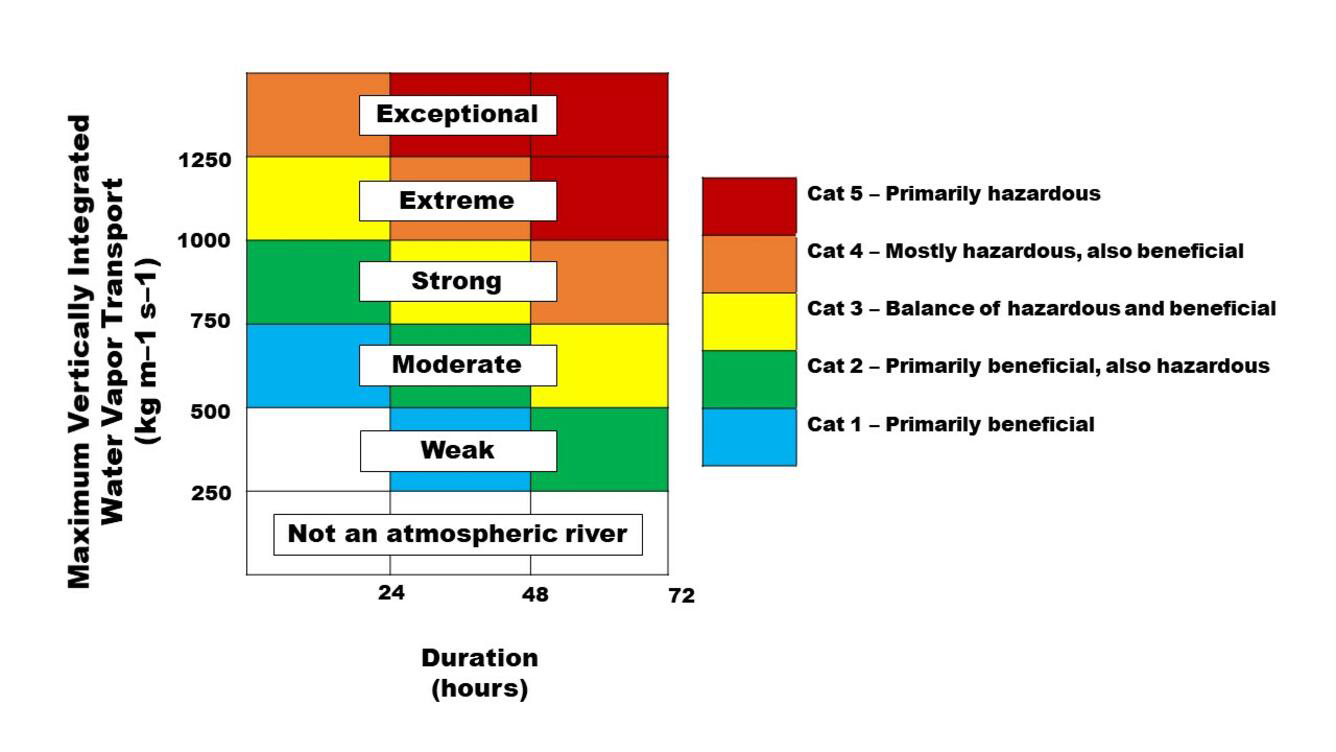
Are atmospheric rivers good or bad?
- Atmospheric rivers produce up to 50% of California's precipitation annually . California gets one to two dozen AR storms per year.
- A typical atmospheric river event lasts about a day. Problems begin when they last longer in duration or occur back-to-back. This can lead to major hazards like flooding, mudslides or ash flow in the aftermath of wildfires.
- ARs were also undoubtedly behind the worst floods in California's history, when the state capital of Sacramento was inundated during the winter of 1861–62.
What is a true Pineapple Express?
- Atmospheric rivers come in different shapes and sizes. A Pineapple Express is a strong atmospheric river that builds up in the tropical pacific, according to the NOAA.
- Some necessary conditions for pineapple express are,
- The moisture is pulled from the tail end. This tail end must start near Hawaii,
- The river must stretch continuously through the atmosphere to the U.S. West Coast.
How is climate change affecting ARs?
- The warmer the atmosphere, the more moisture an atmospheric river can contain. This may not increase the frequency of atmospheric rivers in the future but will make them more intense.
Where to use?
Paper I (General Studies) : Climate change
Paper I (Geography optional): Environmental hazards, Hydrological cycle
Dickinsonia - Edukemy Current Affairs
It is an extinct genus of basal animal that lived during the late Ediacaran period in Australia, China, Russia and Ukraine. The discovery of cholesterol molecules in fossils of Dickinsonia lends support to the idea that Dickinsonia was an animal. Recently, Dickinsonia fossil found in Bhimbetka in 2021 turns out to be decayed beehive.
Carbon Bomb
The term carbon bomb has been widely used in climate circles for the past decade to describe large fossil fuel projects or other big sources of carbon. A coal, oil or fossil gas project with a potential to emit over a Gigaton of CO2 is a carbon bomb. There are 425 of them around the world, according to Guardian. Recently US approved Alaska drilling project, considered as a carbon bomb.
Atmospheric rivers
Atmospheric rivers are relatively long, narrow regions in the atmosphere – like rivers in the sky – that transport most of the water vapor outside of the tropics. These columns of vapor move with the weather, carrying an amount of water vapor. When the atmospheric rivers make landfall, they often release this water vapor in the form of rain or snow. Recently , a powerful atmospheric river arrived in California, caused by “ true Pineapple Express “ – a specific example of atmospheric river.
Conflict wood
It is defined as wood that has been traded or taxed at some point in the chain of custody by armed groups, be they rebel factions or state militaries, or by a civilian administration involved in armed conflict to finance hostilities or otherwise perpetuate conflict. Recent investigation by International Consortium of Investigative Journalists (ICIJ) revealed that India has become the second largest importer of "conflict wood" from Myanmar, after China. Teak Imported from Myanmar Described as “Conflict Wood
High seas
According to United Nations , high seas are “the parts of the sea that do not include the internal water of a state”. The high seas are also called transboundary waters or international waters. It includes marine ecosystems, estuaries, rivers, regional seas, groundwater systems, wetlands, etc. No country shall profess sovereignty over the high seas. After almost a decade of negotiations, recently countries have reached an agreement on a treaty to protect and sustainably use marine biodiversity beyond national boundaries on the high seas.
Bringing tap water to rural Chhattisgarh using solar energy
- The villages of Chhattisgarh are benefitting from individual household tap connections under the Jal Jeevan Mission using solar energy.
- On August 15, 2019, the central government started the Jal Jeevan Mission to make sure rural India gets access to clean drinking water. And the villages of Bastar are prime examples of using renewable energy to provide basic facilities in rural India.
- Access to clean water has really changed the face of rural villages in Bastar.
- Remote settlements in the deep forest areas of the state, which are grappling with issues like lack of electricity and connectivity, would now have access to piped drinking water with the help of solar power-based motorised water pumps.
- Settlements located in the naxal-infested region, would be utilised for installing systems which can pump water to overhead tanks, from where it can be relayed through pipes into the houses of the villagers.
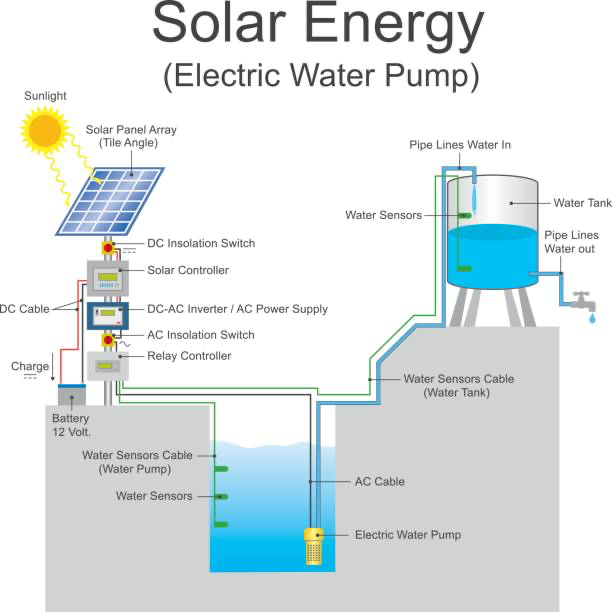
Paper II (Geography Optional) : Resources , Planning for backward area
Map
|
1. Sigur plateau |
It is a plateau in the north and east of Nilgiri District in the Nilgiri Hills of Tamil Nadu.It covers the portion of the Moyar river drainage basin on the northern slopes of the Nilgiri Hills, south of the Moyar River. The Sigur plateau is enclosed by the Bandipur National Park in the northwest, the Sathyamangalam Wildlife sanctuary in the east and the Wayanad wildlife sanctuary in the west. Recently, a proposal has been initiated to notify Sigur and adjoining forest areas as a wildlife sanctuary for Vultures. ( approx . Nilgiri hills) |
|
2. Keeladi |
Keeladi is a village located in Manamadurai taluka of Sivaganga district in Tamil Nadu, on the banks of river Vagai. Recently excavations in the tiny hamlet of Keeladi prove that an urban civilisation existed in Tamil Nadu in the Sangam era. ( approx . Madurai) |
|
3. Gurudongmar lake |
It is one of the highest lakes in the world and in India, at an elevation of 5,430 m. Located in the Great Himalayas in the Mangan District in Sikkim, and considered sacred by Buddhists, Sikhs and Hindus. The lake is named after Guru Padmasambhava—also known as Guru Rinpoche—founder of Tibetan Buddhism, who visited in the 8th century. Recently Union Minister of Finance and Corporate Affairs Nirmala Sitharaman visited Gurudongmar lake. |
|
4. Malpa |
Malpa lies in the Pithoragarh district of Uttarakhand in the Kumaon division of the Himalayas. This area lies in a seismic zone and is listed as the one of the most landslide affected areas in India till date, according to satellite data by the Indian Space Research Organisation (ISRO). ( Approx . pithoragarh ) |
|
5. River Bhogdoi |
The Bhogdoi River is a tributary of the Brahmaputra in India. From its origin in the Naga hills it flows through the city of Jorhat and then it merges with another river and its name becomes Gelabill. Recently, dead fish were sighted in several areas along the banks and these deaths were linked to contamination. (Approx. Jorhat) |
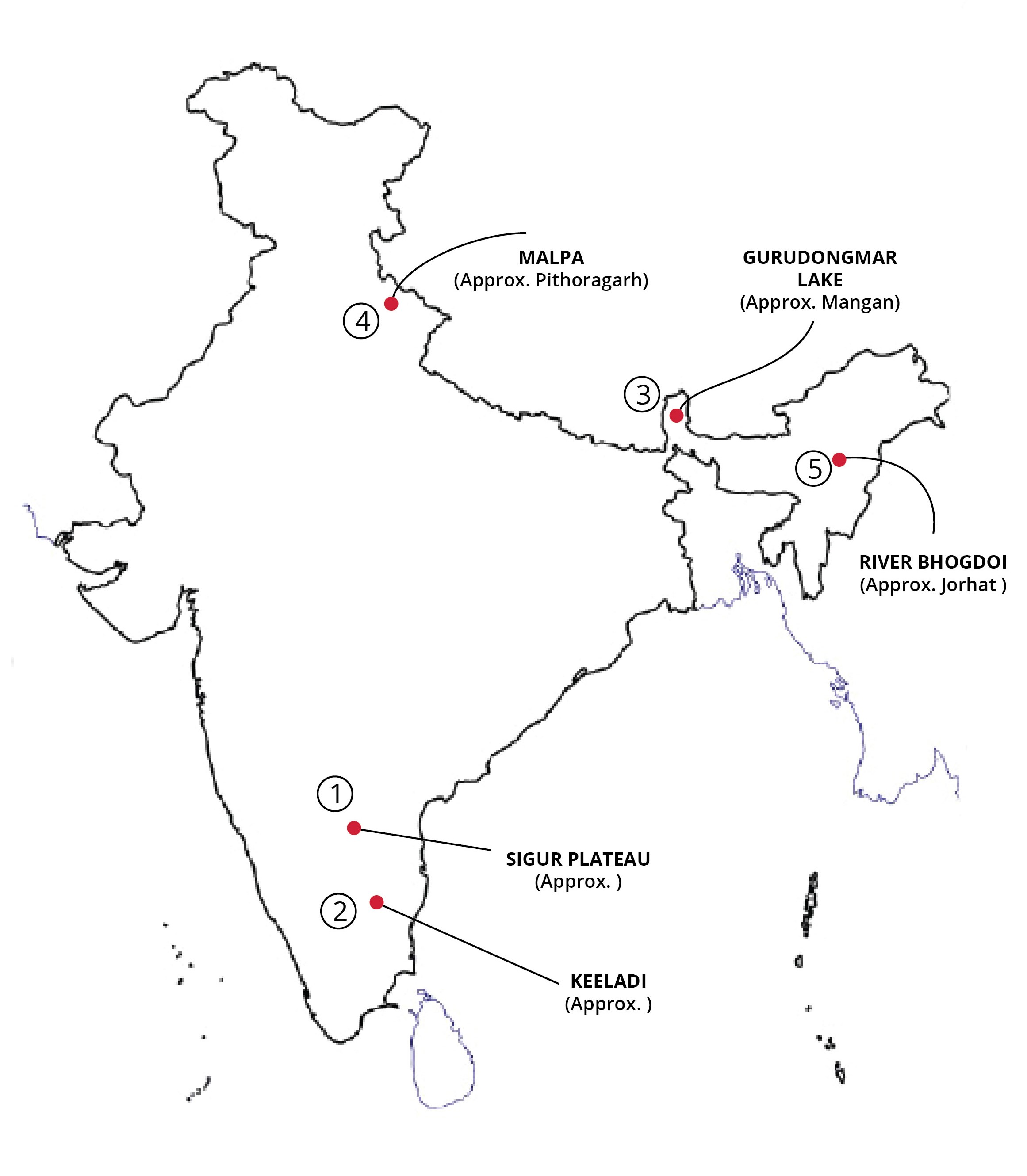
KOSMOS MCQs
Q1. With reference to Humming Bird , consider the following statements:
- Humming birds are well adapted to enclosed spaces like cages and aviaries.
- Hummingbirds have the highest metabolic rate (calories burnt per minute) among vertebrates.
- They are critical pollinators of the ‘Flame of the Forest’.
Which of the above mentioned statements is/ are correct?
- 1 and 2
- 2 and 3
- 1 and 3
- All of the above
Q2. Recently, Scientists, in a new study,have confirmed the existence of a 5th new layer of earth. Which among the following statements regarding it is incorrect?
- This fifth layer is made of the same material as the inner core .
- Maindifference between inner core and fifth layer is the way the atoms are arranged to form a solid.
- It’s temperature is similar to the sun’ surface .
- It has a isotropy, which means homogeneity in all directions.
Q3. Consider the following statements regarding cold tongue (CT) El Niño :
- It is characterised by relatively large SST (Sea Surface Temperature) anomalies in the 5°S–5°N, 150°–90°W.
- It is demonstrated that thermocline feedback plays a crucial role in decaying SST anomaly associated with it.
Which of the above mentioned statements is/ are correct?
- Only 1
- Only 2
- Both 1 and 2
- Neither 1 nor 2
Q4. Consider the following statements regarding Asia Energy Transition Initiative:
- The initiative was inaugurated by India and supported by the Association of Southeast Asian Nations
- Financial assistance of $10 billion for transition through renewable energy would be given by World bank.
Which of the above mentioned statements is/ are correct?
- Only 1
- Only 2
- Both 1 and 2
- Neither 1 nor 2
Q5. With reference to Indian White Shrimp, consider the following statements:
- To promote this indigenous species, ICAR (Indian Council of Agriculture & Research) has taken up the genetic improvement program under the Make in India.
- Greenpeace International opposed the addition of it to its seafood red list as the Indian prawns are already critically threatened.
Which of the above mentioned statements is/ are correct?
- Only 1
- Only 2
- Both 1 and 2
- Neither 1 nor 2
Q6. Recently, a report,"Peak Plastics: Bending the Consumption Curve was released by UN. The report examined which among the following mentioned policies :
- Ban on single-use plastic
- Extended producer responsibility
- Tax on virgin plastic production.
- Recycled plastic roads
Select the correct code:
- 1 and 2
- 1, 2 and 3
- 1, 2 and 4
- 2, 3 and 4
Q7. With reference to types of Forest certification , consider the following statements:
- Chain of Custody (CoC) certification is meant to guarantee the traceability of a forest product like timber throughout the supply chain from origin to market.
- A PEFC (Programme for the Endorsement of Forest Certification ) certified forest is a forest that is managed in line with the strictest environmental, social and economic requirements.
Which of the above mentioned statements is/ are correct?
- Only 1
- Only 2
- Both 1 and 2
- Neither 1 nor 2
Q8. Consider the following animals:
- Sea cow
- Sea horse
- Sea lion
Which of the above is/are mammal mammals?
- 1 only
- 1 and 3 only
- 2 and 3 only
- 1, 2 and 3
Q9. Jerdon's narrow-mouthed frog (Uperodon montanus)was last seen in 1934, thereafter the species faded away permanently. A group of zoologist , after 89 years has observed it again in which among the following regions :
- Himalayas
- Indo Burma
- Western Ghats
- Sundaland
Q10. Consider the following:
Rivers : Animals
- River Beas : Indus River dolphins
- River Brahmaputra : Dancing frog
- River Rapti : Mugger
Which of the above mentioned pairs are correctly matched?
- Only 1 pair is correct
- Only 2 pairs are correct.
- Only 3 pairs are correct.
- None of the pair is correct.
Q11. Consider the following statements regarding International Big Cat Alliance (IBCA) :
- The alliance is aimed to eliminate the private ownership and commercial exploitation of wild cats.
- Except for pumas and jaguars, India is the only nation to have all the big cats
- IBCA will be led by a council of seven members, elected by the UN General assembly
Which of the above mentioned statements is/ are correct?
- 1 and 2
- 2 and 3
- 1 and 3
- All of the above
Q12. Consider the following :
Species : Habitat areas
- Great Indian Bustard : Gujarat
- Humped back Mahseer : Kaveri river
- Black Necked crane : Ladakh
Which of the above-mentioned pairs are correctly matched?
- 1 and 2 only
- 2 only
- 2 and 3 only
- 3 only
Q13. Consider the following statements regarding Landslide Atlas of India :
- The atlas used satellite data of ISRO to map all seasonal and event-based landslides
- The Landslide Atlas of India is prepared by National Institute of Disaster Management .
Which of the above mentioned statements is/ are correct ?
- Only 1
- Only 2
- Both 1 and 2
- Neither 1 nor 2
Q14. Consider the following statements regarding Sigur plateau:
- In this plateau, rainfall is locally variable, with the western part of the plateau lying in a rain shadow region.
- The forests over the plateau are home to indigenous tribal people belonging largely to the Kasaba sub-group of the Irular community
Which of the above mentioned statements is/ are incorrect?
- Only 1
- Only 2
- Both 1 and 2
- Neither 1 nor 2
Q15. With reference to Atmospheric rivers , consider the following statements:
- Atmospheric rivers are always flowing somewhere on Earth, even though they don’t consistently stay in one place like rivers on the ground
- While other rating systems are focused solely on the hazards of the event, the atmospheric river system incorporates the idea that these events can be beneficial, hazardous, or both.
Which of the above mentioned statements is/ are incorrect?
- Only 1
- Only 2
- Both 1 and 2
- Neither 1 nor 2
Share the article
Get Latest Updates on Offers, Event dates, and free Mentorship sessions.

Get in touch with our Expert Academic Counsellors 👋
FAQs
Geography Current Affairs focuses on the contemporary issues, events, and developments in the field of geography. It covers recent geographical phenomena, environmental changes, geopolitical shifts, and related news. This differs from regular geography studies which may focus more on foundational concepts, historical contexts, and theoretical frameworks.
Updates are provided regularly to ensure that subscribers stay informed about the latest developments in geography. Typically, updates are provided on a fortnightly basis, depending on the frequency of significant events and changes in the field.
Absolutely. Geography Current Affairs serves as a valuable resource not only for Geography optional but also for GS papers, especially GS Paper 1 (covering Indian Heritage and Culture, History, and Geography of the World and Society) and GS Paper 3 (covering Technology, Economic Development, Biodiversity, Environment, Security, and Disaster Management). It aids in building a holistic understanding of various topics and strengthens answer-writing skills by incorporating contemporary examples and perspectives.
Geography Current Affairs holds immense importance for UPSC preparation, particularly for aspirants opting for Geography optional. It helps candidates stay updated with the latest developments, geographical phenomena, environmental issues, and geopolitical shifts worldwide, aligning them with the dynamic nature of the subject as tested in the UPSC examinations.

